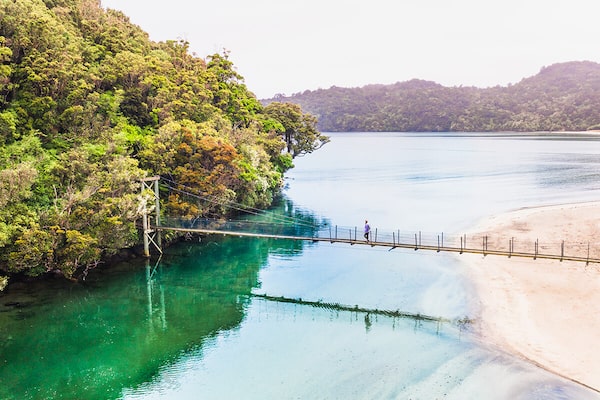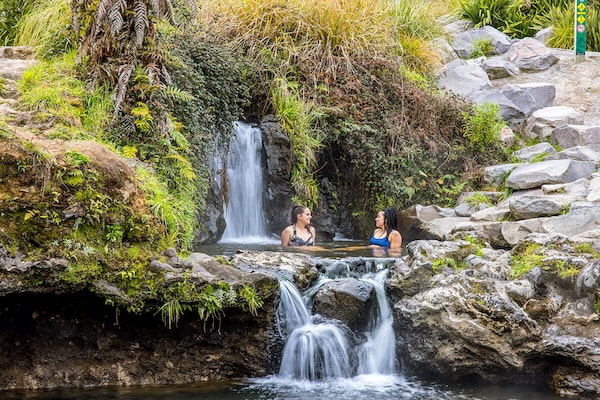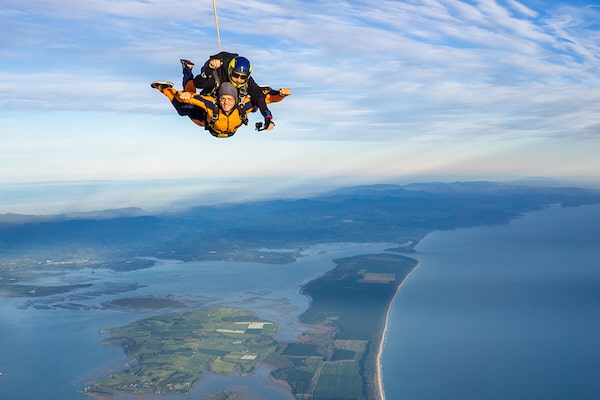
The diversity of experiences and excursions across New Zealand ensure that every traveller has the trip of a lifetime, no matter their vacation style.Great South
Whether you’re a thrill seeker or a wellness buff, New Zealand has plenty of options
No matter what your trip looks like, New Zealand’s breathtaking views, lush forests and pristine waters will make your visit one to remember. The islands in this corner of the world are home to glaciers, mountains and endless coastline with sandy beaches, plus thousands of kilometres of trails to explore.
Whether you’re in pursuit of high-adrenaline activities like skydiving or looking for total relaxation at a luxe spa, the country has something for every traveller.
On land
For the adventurer: Hike the Rakiura Track
One of the Great Walks of New Zealand, the 32-kilometre Rakiura Track is a three-day hike on Stewart Island that follows open coastline, forest and Paterson Inlet’s sheltered shores. The island is home to a huge bird population, including Brown Kiwis (a.k.a. the Rakiura tokoeka)—be sure to listen for its call and look out for its footprints.
You can stay in one of two huts or camp out at one of three sites along the way, including Maori Beach which was once home to a Māori village and sawmill. Most of the track is board-walked, but it can get muddy during long periods of rain, so bring some rubber boots along just in case.
For the wellness seeker: Forest bathing in the Whirinaki Forest
Relieve stress and boost your mood by taking in the sights, smells and sounds of the Whirinaki Forest on an eight-and-a-half-hour forest bathing tour with Whirinaki Footsteps. On this 12-kilometre walk, you’ll be led by local Māori guides through a Jurassic podocarp rainforest that’s home to 2,500 native species of plants, ferns and conifers, as well as endangered wildlife like the blue duck. The tour follows a loop around the Whirinaki River through majestic forest.
Highlights include being able to touch a 1,000-year-old Totara tree, filling up your canteen with fresh water and a “forest-to-fork” picnic lunch stop. You’ll also learn about rongoā Māori, the traditional healing system of Māori, which includes medicinal remedies derived from trees, fruits, moss and more. You’ll even have a chance to taste some yourself!

Hot springs are plentiful in New Zealand because the country is located at the meeting of two tectonic plates, which causes a lot of geothermal activity. These hot pools often contain abundant minerals, which some believe have therapeutic effects.Supplied
By sea
For the adventurer: Go diving at the Poor Knights Islands
To experience some of the world’s best diving, book a day trip to the Poor Knights Islands with Dive! Tutukaka. The Islands are home to dolphins, whales, stingrays, moray eels and countless species of fish. This day trip, which is suitable for both beginners and pros, hosts two dives at different sites. You’ll also get a chance to explore the incredible volcanic rock archways, cliffs and caves – including Riko Riko, the largest surveyed sea cave in the world. If you’re not a certified diver, you can take a course first with Dive! Tutukaka first, or go kayaking or snorkeling around the Islands instead.
For the wellness seeker: A visit to Rotura’s hot pools
Let stress melt away in the therapeutic waters of Polynesian Spa, the country’s original geothermal bathing experience. Located in Rotura, which is in the Taupo Volcanic Zone, the spa offers 28 hot pools sourced by two different natural mineral springs. The Priest Spring has slightly acidic water that helps relieve aches and pains, while the Rachel Spring is a source of alkaline water that nourishes skin. For a bite to eat in between soaks, stop by the Māori-owned-and-operated ANI’s Gin Bar and Tapas Restaurant for local fare like South Island queen scallops. (You can even build your own cocktail with locally-made Duo gin.) If you’re feeling really indulgent, consider a hot pool crawl. The Secret Spot is a great spot to book an hour of secluded hot tub time amongst the trees.

No wonder New Zealand bills itself as the Adventure Capital of the World. It’s not just a beautiful place to skydive; tandem skydiving was actually invented in Queenstown and there are dozens of places to try it throughout the country.Skydive Tauranga
By sky
For the adventurer: Go skydiving in Queenstown
What better way is there to see New Zealand’s stunning views than from 15,000 feet up in the air? Queenstown, known as the adventure capital of the world, is where tandem skydiving originated. Sign up for a jump with NZONE Skydive Centre, where you’ll be harnessed to a qualified Jumpmaster before stepping out of an airplane and freefalling for 60 seconds before a four- to five-minute parachute ride. At that altitude, you’ll be able to see a bird’s eye view of the Wakatipu basin’s remarkable mountains and lakes. Don’t forget to smile at the photographer as you take it all in! Even the drop zone is stunning – it’s located at the base of the famous Remarkables mountain range, surrounded by a working sheep farm.
For the wellness seeker: Book a stay at a cabin in the mountains at Owhaoko
Located on a remote 6,950 hectares of mountainous terrain on the North Island, Owhaoko’s mountain cabin is so private that it’s only accessible by helicopter. There are no roads, no people and no cell phone coverage. Book a hosted stay through Chris Jolly Outdoors, which will ensure all of your meals and other needs are taken care of. You can even book a private chef for your stay and set out on hikes around the area to learn about the land. But the best part is the manuka honey: Each summer, around 1,200 beehives are flown in by helicopter and placed near dense manuka bush, where bees can forage the nectar at the highest altitudes in the North Island. The result is a soft honey with warm herbal notes and medium sweetness, the perfect way to cap off the most memorable trip.
Advertising feature produced by Globe Content Studio with Tourism New Zealand. The Globe’s editorial department was not involved.